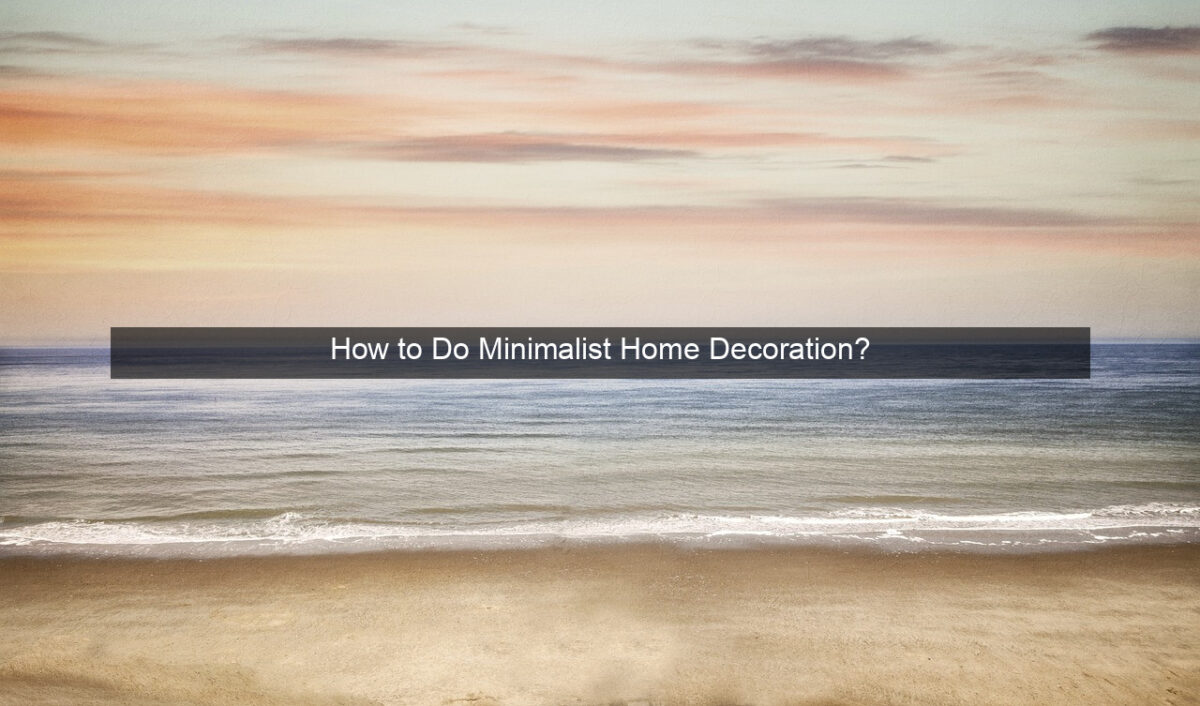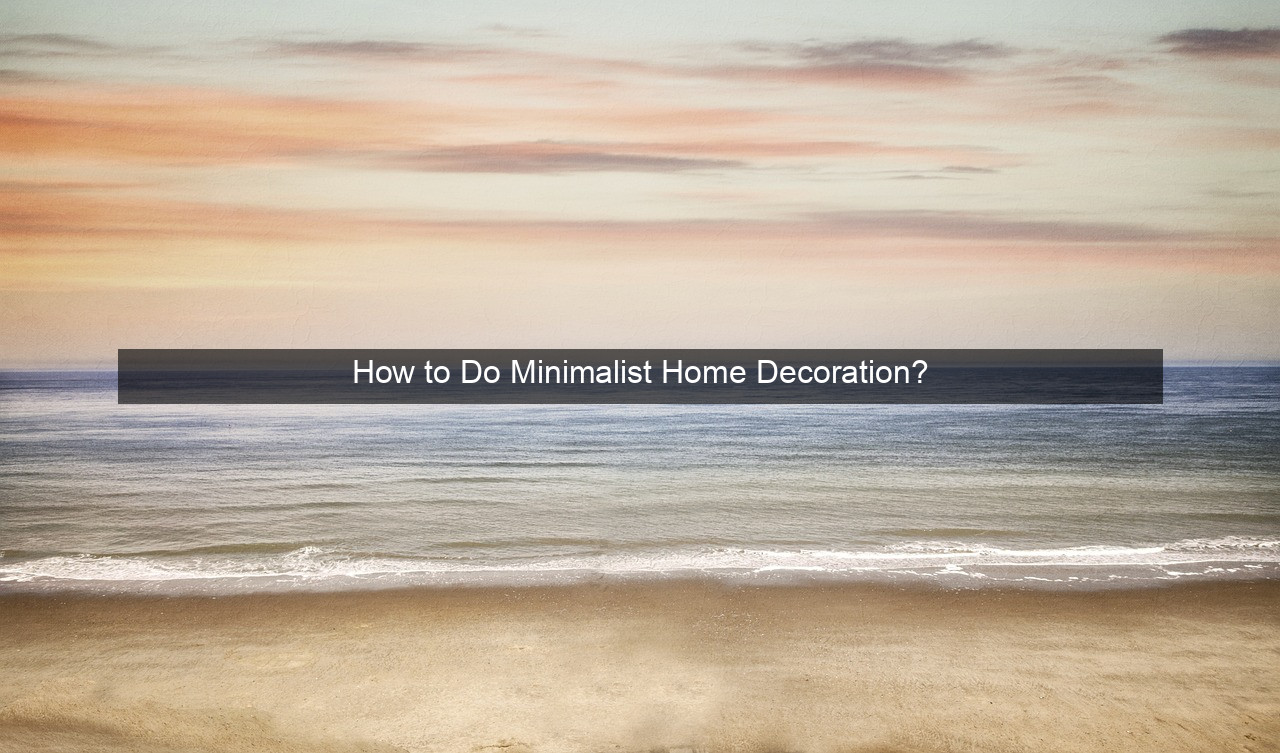How to Do Minimalist Home Decoration?

- How to Do Minimalist Home Decoration?
- Decluttering: The Foundation of Minimalism
- Clearing the Clutter
- Organizing Essentials
- Choosing the Right Furniture
- Focusing on Functionality
- Embracing Neutral Colors
- Accessorizing with Intention
- Less is More
- Creating Focal Points
- Maximizing Natural Light and Space
- Embrace Natural Light
- Creating Openness

Less is More: Embracing Minimalist Home Decor
Minimalism isn’t just a trend; it’s a lifestyle choice reflecting a desire for simplicity and intentionality. It’s about curating a space that promotes peace and functionality over clutter and excess. Minimalist home decor focuses on clean lines, neutral color palettes, and a careful selection of essential items. This approach creates a calming environment that allows you to breathe and appreciate the beauty of simplicity. This guide will explore how to achieve this aesthetic in your own home, offering practical tips and insights to help you declutter, organize, and embrace the minimalist ethos. From decluttering your space to choosing the right furniture and accessories, we’ll cover the essential elements of minimalist home design. Discover how to transform your home into a sanctuary of calm and order.

Decluttering: The Foundation of Minimalism
Clearing the Clutter
The first step towards minimalist decor is decluttering. This involves systematically going through your belongings and discarding or donating items you no longer need or use. Start with one room or even a single drawer and be honest with yourself about what truly adds value to your life. This process can be liberating, freeing you from the burden of excess possessions.
Consider the “one in, one out” rule: for every new item you bring into your home, remove a similar item. This prevents clutter from accumulating over time. Focus on quality over quantity, investing in durable, well-made pieces that will last.
As you declutter, categorize your belongings: keep, donate, or discard. This makes the process more efficient and less overwhelming. Remember, minimalism is about being intentional with what you surround yourself with. Keep only items that serve a purpose or bring you joy.
Organizing Essentials
Once you’ve decluttered, organize the remaining items. Invest in smart storage solutions like shelves, drawers, and baskets to keep your belongings tidy and out of sight. Maximize vertical space with wall-mounted shelves and utilize under-bed storage for items you don’t use frequently.
Labeling storage containers can help you maintain order and quickly locate items when needed. Group similar items together, such as books, clothes, or kitchen utensils, for easy access. Regularly reassess your belongings and declutter as needed to prevent clutter from building up again.
Consider incorporating multi-functional furniture, such as ottomans with storage or sofa beds, to maximize space and minimize clutter. This allows you to keep your belongings organized while also serving a practical purpose.
Choosing the Right Furniture
Focusing on Functionality
When choosing furniture for a minimalist home, prioritize functionality over ornamentation. Opt for pieces with clean lines and simple designs that serve a clear purpose. Avoid overly ornate or fussy furniture that can visually clutter a space.
Invest in high-quality, durable pieces that will stand the test of time. Choose furniture made from natural materials like wood or metal for a timeless and sustainable approach. Consider the scale of your furniture in relation to the size of your room. Oversized furniture can make a small space feel cramped, while undersized furniture can look lost in a larger room.
Think about the flow of movement within the room and arrange furniture in a way that promotes easy navigation. Avoid overcrowding the space with too much furniture. Leave ample room to walk around and create a sense of openness.
Embracing Neutral Colors
A neutral color palette is a hallmark of minimalist decor. Whites, grays, beiges, and other muted tones create a calming and cohesive atmosphere. These colors also serve as a versatile backdrop for accent pieces and artwork.
Consider incorporating different shades and textures within your neutral palette to add depth and interest. Use textured fabrics, such as linen or wool, to add warmth and visual appeal. Introduce pops of color sparingly with accessories or artwork to create focal points.
Natural light plays a crucial role in minimalist design. Maximize natural light by keeping windows unobstructed and using light-colored curtains or blinds. This enhances the sense of spaciousness and creates a brighter, more inviting environment.
Accessorizing with Intention
Less is More
In minimalist decor, accessories are used sparingly and intentionally. Choose a few carefully selected items that add personality and visual interest without cluttering the space. Avoid over-accessorizing, as this can detract from the minimalist aesthetic.
Consider incorporating natural elements, such as plants, wood, or stone, to bring a sense of the outdoors in. These elements add texture and warmth to a minimalist space. Choose accessories that reflect your personal style and interests, but avoid anything too trendy or fleeting.
Focus on quality over quantity when selecting accessories. Invest in a few well-made pieces that you truly love rather than a collection of inexpensive items. This creates a more curated and sophisticated look.
Creating Focal Points
Strategically placed accessories can create focal points in a minimalist space. A single piece of artwork, a sculptural vase, or a collection of books can add visual interest and personality. Consider using lighting to highlight specific areas or objects.
Use negative space to your advantage. Empty space is not wasted space in minimalist design. It allows the eye to rest and appreciate the simplicity of the space. Avoid filling every corner with accessories. Let the emptiness breathe.
A well-placed mirror can enhance natural light and create the illusion of a larger space. Choose a simple, frameless mirror or one with a thin, understated frame. Hang it strategically to reflect light and add depth to the room.
Maximizing Natural Light and Space
Embrace Natural Light
Natural light is a key element in minimalist design. Maximize natural light by keeping windows unobstructed and using light-colored curtains or blinds. This enhances the sense of spaciousness and creates a brighter, more inviting environment.
Consider using mirrors to reflect natural light and create the illusion of a larger space. Place mirrors strategically to bounce light into darker corners of the room. This can brighten up the space and make it feel more open.
Choose light-colored wall paint to reflect light and create a sense of airiness. White, beige, and other pale hues can make a room feel larger and more spacious. Avoid dark colors, which can absorb light and make a room feel smaller.
Creating Openness
Minimalist design emphasizes open space and clean lines. Avoid cluttering the space with too much furniture or accessories. Choose furniture with a small footprint and arrange it in a way that promotes easy movement.
Use vertical space to your advantage. Install shelves or wall-mounted storage units to keep belongings organized and off the floor. This creates a sense of visual lightness and prevents the space from feeling cramped.
Maintain clear pathways and avoid obstructing walkways with furniture or accessories. This allows for easy navigation and enhances the sense of openness.
| Element | Minimalist Approach |
|---|---|
| Color Palette | Neutral tones (white, beige, gray) |
| Furniture | Functional, simple designs |
| Accessories | Sparingly used, intentional choices |
- Declutter regularly
- Choose quality over quantity
- Maximize natural light
Conclusion
Minimalist home decor offers a path to a more intentional and fulfilling life. By decluttering, simplifying, and focusing on functionality, you create a space that promotes peace, tranquility, and a deep appreciation for the things that truly matter. Embrace the beauty of less and discover the transformative power of minimalist living.
How do I start decluttering my home for a minimalist look?
Start small, focusing on one room or even a single drawer. Be honest about what you truly need and use. Categorize items into keep, donate, or discard piles.
What are the key elements of minimalist furniture?
Minimalist furniture features clean lines, simple designs, and a focus on functionality. Natural materials like wood or metal are often preferred.
What color palette is best for minimalist decor?
Neutral colors like white, beige, gray, and other muted tones create a calming and cohesive atmosphere

